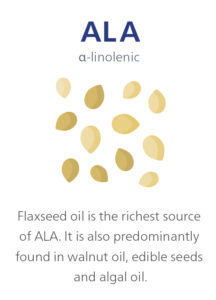The last word on Omega

Omega-3 fatty acids play a crucial role in fish and human health
Everybody knows that omega-3 fatty acids, or n-3 fatty acids, are good for you and that you should have a regular intake of them. The best-known n-3 fatty acids are the short-chain α-linolenic acid (ALA, 18:3n-3) and the long-chain polyunsaturated fatty acids (PUFAs) EPA (20:5n-3) and DHA (22:6n-3). ALA-rich foods include nuts – especially walnuts – along with leafy vegetables, flaxseed, flaxseed oil, other vegetable oils, and some animal fats, especially in grass-fed animals. ALA once consumed can elongate into EPA and DHA, typical marine n-3 fatty acids also found in fish and shellfish. These fatty acids play key roles in multiple essential body functions, including cardiovascular health, immunity, brain function, and even eye function.

Lifestyle changes
The original diet of humans was rich in vegetables, fruit, nuts and fish; fish were so central to the diet that most humans settled and stayed close to oceans or rivers. This diet provided the right intake of omega-3 fatty acids next to vitamins, minerals and proteins. The Mediterranean diet of today, including seafood, vegetables, fruits, whole grains, nuts and olive oil, is close to this original diet, and it is considered one of the healthiest ways to eat.

However, over millennia and especially in recent decades, people’s lifestyles changed, and the Western diet in particular has shifted to one filled with refined carbohydrates and saturated fats and offering much less nutrition from vegetables, fruit, nuts and fish. This new diet has resulted in a rather low intake of omega-3 fatty acids and a high intake of n-6 fatty acids; the healthy n-6/n-3 ratio of 4:1 has changed to an unhealthy n-6/n-3 ratio of 15:1. Since an imbalance here is a risk factor for developing obesity, Type 2 diabetes, and coronary heart disease, dieticians are trying to change these eating habits with the help of food scientists and producers.
Balanced intake
For humans, two fatty acids are considered essential in the diet because they cannot be synthesized: linoleic acid (LA, 18:2n-6) and α-linolenic acid (ALA, 18:3n-3).
Normally, linoleic acid intake is sufficient even in a substandard diet, but meeting the recommended ALA intake takes more effort and especially awareness. Consuming more ALA – the European Food Safety Authority (EFSA) recommends two to three grams per day – is a good start, but it’s not enough, because humans and many fish species are poor converters of ALA into EPA and DHA. For this reason, the EFSA also recommends a daily intake of 250 mg of EPA and DHA combined. The ratio of EPA to DHA may vary as long as the total is 250 mg.
For humans, this EPA and DHA requirement can be met by eating oily fish once or twice a week. Eating fish regularly also helps to get the omega-6/omega-3 balance right again. Fish, shellfish and marine algae are the only source of the essential fatty acids EPA and DHA!

The reason why salmonid fish – including not only salmon but trout, whitefish, char, and more – score so high as a healthy food is their high content of EPA and DHA, provided that their diet contained sufficiently high levels of these two fatty acids. However, because EPA and DHA sources are expensive, salmonid feeds have been formulated over the years to contain less and less of them, just enough to meet the requirements of the fish. This has led to a lower nutritional value of fillets for human consumption in terms of EPA and DHA, often requiring double portion sizes to meet the EFSA recommendation.
Finnish partner Finnforel
Alltech Coppens has always ensured ample EPA and DHA in their fish feeds, and now they have gone the extra mile with Finnish partner Finnforel, which shares the Alltech Coppens mission to support sustainable farming practices and unlock new sources of nutrition for consumers. Finnforel wanted to buck the lower EPA and DHA trend, producing fish particularly rich in EPA and DHA, and they teamed with Alltech Coppens to advance that effort.
Feed trials
Together with Finnforel, Alltech Coppens has developed a unique range of feed. The basis for this was laid at the Alltech Coppens Research Center, where a series of feed trials provided insight into how to amplify the amounts of these long-chain PUFAs in the flesh of salmonids, specifically trout. This principle was then validated by a large field trial at Finnforel’s leading-edge RAS (recirculating aquaculture system) farm, demonstrating that the resulting trout were exceptionally rich in EPA and DHA. This was excellent news for the health of the trout and for the health of the consumers who would eat them!
Alltech Coppens’ feed range provides a major contribution to adequate EPA + DHA intake and to getting the omega-6/omega-3 ratio right in the diets of today.
![]()

